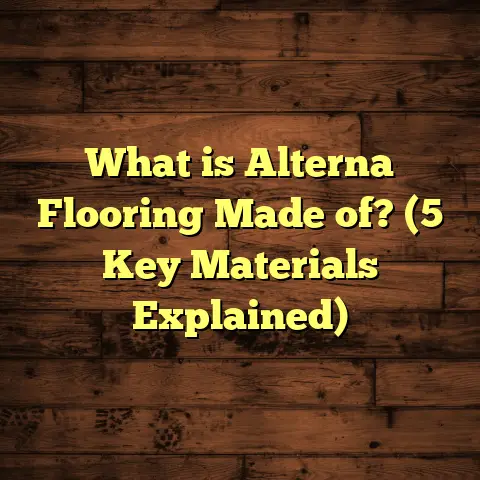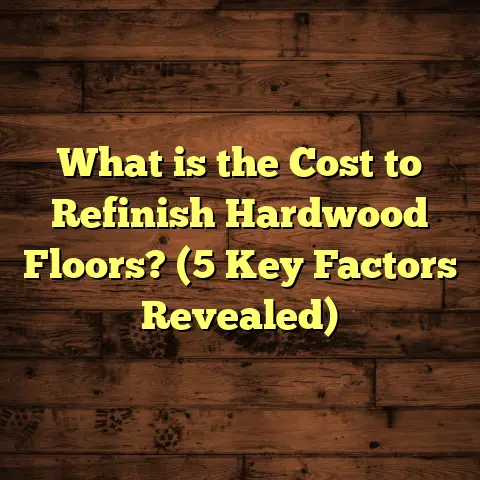What is the White Specks on My Hardwood Floor? (5 Surprising Causes)
Allergies can really throw a wrench into your daily comfort at home. I’ve always had a sensitive nose and eyes when it comes to dust and mold, so I’m pretty vigilant about keeping my living space clean and healthy. But every now and then, I’d find these tiny white specks scattered across my hardwood floors. It bugged me more than just a little. Was it dust? Paint? Mold? Or worse—pests? If you’ve ever found yourself staring at similar white dots on your floors and wondering what they are, you’re not alone.
Let’s talk about what those white specks really are, why they show up, and what you can do about them. I’ll share some stories from my own flooring work and homes I’ve helped with, plus some data and tips that can save you time and money.
What Is the White Specks on My Hardwood Floor?
At first glance, white specks on hardwood floors look like tiny dust particles or little flakes of something unknown. But that simple appearance can mean very different things depending on the cause.
Sometimes those specks are just harmless residue from cleaning. Other times they’re a warning sign of moisture issues, pest problems, or finish breakdown. Understanding the source is key to knowing how to fix or prevent them.
I’ll walk you through five common—and sometimes surprising—causes I’ve encountered over the years. Some of these might sound familiar if you’ve recently cleaned, renovated, or noticed changes in your home environment.
Before we dig into each cause, here’s what I want you to keep in mind: hardwood floors are living surfaces. They respond to moisture, dirt, environmental changes, and wear differently than tile or carpet. So white specks aren’t always just a cleaning nuisance—they can be clues to underlying issues.
1. Dry Mop or Cleaning Residue: The Most Common Culprit
You might think you’re doing your floors a favor by cleaning them regularly with water and floor cleaner. But here’s the catch—too much water or the wrong kind of cleaner often leaves behind mineral deposits or soap residue that dries as white specks or haze.
Why does this happen?
Water used for mopping often contains minerals like calcium and magnesium. When the water evaporates, these minerals don’t disappear; they settle back on the floor as a fine white powder. Add in certain soaps or detergents that don’t rinse easily, and you get spots or streaks.
According to a study by the Hardwood Flooring Manufacturers Association (HFMA), improper cleaning with excess water is one of the top causes of surface damage and residue buildup on hardwood floors.
How can you tell it’s residue?
- The white specks come off easily with a damp microfiber cloth.
- You notice the spots mostly after cleaning.
- The specks are scattered thinly rather than clustered in one area.
How do I avoid or fix it?
- Use hardwood-specific cleaners that are pH-neutral.
- Avoid soaking the mop; wring it out well so it’s just damp.
- After mopping, immediately dry the floor with a clean microfiber cloth.
- Don’t use harsh detergents or wax-based cleaners unless recommended for your flooring type.
I had a client who was using a generic household cleaner on their beautiful oak floors. After switching to a hardwood cleaner and adjusting their mopping habits, those pesky white specks disappeared within a week. It took some retraining but was worth it for the floor’s lasting shine.
2. Paint or Drywall Dust: The Renovation Aftermath
Have you recently painted a room or done drywall work? If so, your floors might be hosting leftover paint chips or drywall dust masquerading as white specks.
What happens during renovation?
Sanding drywall produces extremely fine dust that spreads everywhere—even after vacuuming and wiping surfaces. Paint splatters that dry and chip off look like tiny flakes too.
In my experience working post-renovation cleanup for homeowners, even small painting projects can leave behind dust that lingers weeks after the job is done.
How to identify this kind of white speck?
- The white specks feel powdery or flaky.
- They appear mostly near walls or where construction took place.
- Sometimes you’ll see larger paint chips mixed in.
How do you get rid of drywall dust or paint chips?
- Vacuum thoroughly with a HEPA-filter vacuum to trap fine particles.
- Use a damp mop after vacuuming to lift any remaining dust.
- For paint chips, gently scrape with a plastic scraper or use mineral spirits if safe for your floor type.
- Consider sealing floors before renovation next time to protect them from dust penetration.
A case worth sharing: A family painted their living room walls but didn’t protect the floor well. Weeks later, they called me frustrated over constant white dust spots. We did a thorough cleaning with HEPA vacuuming and mop treatment which finally cleared it up.
3. Mold or Mildew Growth: The Hidden Danger
This might sound alarming—but some white specks could be early mold or mildew growth on or beneath your hardwood floor surface.
How does mold get there?
Hardwood floors exposed to excessive moisture—leaks from pipes, spills left unattended, or high indoor humidity over time—can develop mold spores. Initially, mold may appear as tiny white dots before darkening or growing fuzzy patches.
I’m personally allergic to mold spores, so when I spot anything suspicious like this during inspections, I act fast.
What health concerns does mold bring?
Mold spores can trigger allergic reactions including sneezing, itchy eyes, skin irritation, and respiratory issues. The Environmental Protection Agency (EPA) estimates that indoor mold exposure affects millions of people annually.
How to recognize mold-related white specks?
- Specks cluster in damp or shaded areas.
- You notice musty odors near the floor.
- Specks don’t wipe off easily with water.
- You might see discoloration spreading beyond white—gray or black spots.
What should you do if you suspect mold?
- Increase ventilation immediately by opening windows or using fans.
- Reduce indoor humidity below 50% using dehumidifiers.
- Clean affected areas with diluted vinegar solution (1 part vinegar to 4 parts water).
- Avoid bleach—it can damage wood finishes.
- If infestation seems extensive, call a professional for mold remediation.
A story from one of my clients: They ignored small white spots near a basement door for months. Eventually, it was diagnosed as mold growth due to humidity from poor ventilation. The cleanup involved removing affected wood sections and improving drainage outside the house—a costly lesson about early detection.
4. Pest Droppings or Residue: Wood-Boring Insects at Work
This one is less common but worth knowing about—some insects leave behind tiny white specks as evidence of their activity inside wood floors.
Which insects cause this?
Termites and powderpost beetles tunnel through wood, leaving behind frass—a mixture of wood particles and insect droppings. This frass looks like fine white or yellowish powder scattered near holes or cracks in wood.
According to the National Pest Management Association (NPMA), termite damage costs homeowners over $5 billion per year in repairs.
Signs your white specks are pest-related:
- Specks accumulate near baseboards, corners, or cracks.
- You see tiny round holes in floorboards.
- Tapping the wood sounds hollow or soft.
- You may also notice winged insects near windows in warmer months.
What to do if pests are the cause?
- Do not ignore it; call an exterminator immediately.
- Avoid disturbing infested wood until inspected.
- Professional treatment often includes chemical barriers and fumigation.
- Repair flooring damage after pest removal.
I once helped a homeowner who thought their white specs were cleaning residue. On inspection, we found active termite tunnels under the floorboards requiring urgent treatment before further damage occurred.
5. Natural Aging and Finish Breakdown: Time Takes Its Toll
Sometimes those white flakes are not “foreign” at all—they’re part of your floor’s natural aging process as its finish breaks down over time.
Why does finish break down?
Exposure to sunlight (UV rays), foot traffic abrasion, changes in temperature/humidity, and harsh cleaning chemicals cause finishes like polyurethane to degrade. Small flakes or powders of finish can peel off as white specks.
Data from the International Wood Flooring Association (IWFA) shows that average hardwood floor finishes last around 7–10 years depending on usage and care before refinishing is recommended.
How do you know it’s finish breakdown?
- White flakes don’t dissolve when wiped with water.
- Specks often appear in high-traffic areas.
- Floors look duller with visible wear patches.
What can you do about it?
- Avoid harsh chemical cleaners; use pH-neutral products only.
- Keep humidity levels stable (between 35%–55%) to prevent excessive expansion/contraction.
- Schedule professional refinishing every decade or as needed to restore protective layers.
I’ve seen clients extend their floor life significantly just by following proper maintenance routines and refinishing on time.
Digging Deeper: More Detailed Insights & Data
I want to share some additional insights I gathered from industry sources and research because understanding these causes helps us be smarter caretakers of our hardwood floors.
Cleaning Residue Statistics
A survey by Floor Trends magazine found that 62% of flooring problems reported by homeowners were related to improper cleaning methods leading to buildup on surfaces. Overuse of water was cited in 78% of those cases.
Mold Growth Data
The EPA estimates that 20–50% of indoor environments have visible mold contamination at some point due to moisture problems. Homes with poor ventilation have up to 30% higher risk of mold growth on wooden surfaces including floors.
Pest Damage Insights
Termite infestations tend to go unnoticed for years because damage occurs under surface layers. The NPMA reports that 1 in 5 homes in termite-prone areas experience active infestations annually.
Finish Lifespan Research
Studies by hardwood finishing manufacturers show that finishes exposed to direct sunlight degrade up to 50% faster than shaded areas. Using UV-protective coatings during refinishing helps extend lifespan significantly.
Personal Stories That Helped Me Learn
I want to share some personal flooring stories I’ve encountered over the years because sometimes real-life examples stick better than facts alone:
Story 1: The Renovation Dust Dilemma
A young couple was ecstatic after remodeling their kitchen but complained about constant dusty white specks even weeks after cleaning. We determined drywall sanding dust was settling deep into floor grain because no sealant was used prior to renovation. Post-cleanup and sealing advice made their floors sparkle again.
Story 2: The Moldy Basement Floor Scare
An older home had persistent musty smell and tiny white spots near basement stairs. Testing confirmed mold due to poor drainage outside causing moisture seepage under floors. They invested in drainage repair plus professional mold treatment which solved their allergy flare-ups too.
Story 3: Termite Trouble in Suburban Home
A mid-century house showed small holes and powdery deposits at baseboards. Inspection revealed termites actively damaging subflooring beneath hardwood boards. Early detection saved major reconstruction costs through targeted pest control intervention.
How I Approach Diagnosing White Specks
When I’m called out for mysterious white specks on floors, here’s my usual approach:
- Ask questions: When did the spots appear? Any recent cleaning or renovation? Any leaks?
- Visual inspection: Check distribution patterns—are they near walls? High traffic areas? Damp spots?
- Touch test: Can I wipe them off? Are they powdery or flaky?
- Smell check: Any musty odor indicating possible mold?
- Tap test: Does wood sound hollow suggesting pest damage?
- Moisture meter reading: Checking wood’s moisture level helps spot hidden leaks or humidity problems.
- Recommend action: Cleaning technique change, pest control referral, mold remediation, or refinishing schedule based on findings.
This thorough approach saves guesswork and ensures proper treatment rather than masking symptoms temporarily.
Practical Tips for Hardwood Floor Care & Prevention
Since spotting those white specs made me more attentive to floor health overall, here are some tips I pass along:
- Use microfiber mops dampened with hardwood-safe cleaners to avoid residue buildup.
- Immediately wipe up spills to prevent moisture damage and mold growth.
- Maintain indoor humidity between 35–55% using humidifiers/dehumidifiers based on season.
- Seal floors before renovations to protect against dust intrusion.
- Inspect floors regularly for signs of pest damage during seasonal checks.
- Refinish floors every 7–10 years depending on wear patterns and finish condition.
- Consider UV-blocking window treatments to reduce sun damage on floors.
How Tools Like FloorTally Help Me Manage Flooring Projects
When planning repair or installation projects related to these issues — especially refinishing or replacement — accurate budgeting is key.
FloorTally has been a game-changer for me in estimating project costs based on local labor/material rates without hours of manual calculations. It helps me:
- Input different material types and grades for customized estimates.
- Factor in waste percentages so I order enough materials without excess leftover.
- Visualize total costs clearly which helps set client expectations upfront.
- Save time comparing prices across suppliers quickly using local data integration.
While it’s not about promotion, having such tools frees me up from number crunching so I can focus more on quality workmanship and client communication.
Wrapping Up My Thoughts on Those White Specks
White specks aren’t just an annoying mystery—they’re little signals your hardwood floors send about what’s going on underfoot. Whether it’s leftover cleaning residue, renovation dust, mold growth, pest activity, or aging finish breakdown, knowing what causes those spots helps you take smart steps toward fixing them early before small issues become costly headaches.
If you’re ever unsure about what those white dots mean in your home after examining them carefully, getting a professional opinion is always wise. Hardwood floors are an investment worth protecting—not just for appearance but also for your health and home value over time.
So next time you see those tiny white specs, don’t brush them off too quickly! Dig into what’s behind them—you might be surprised what you learn about caring for your floors better than ever before.
Have you dealt with mysterious white specks on your hardwood floor? What did you find out? Feel free to share your story!





